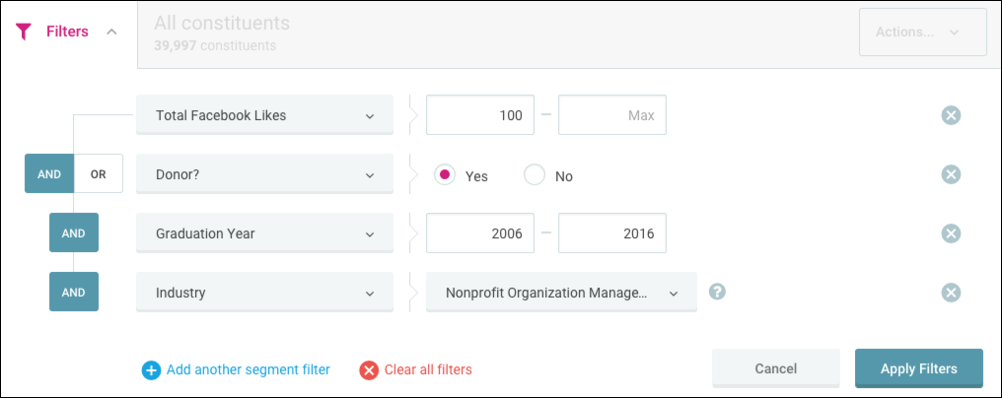As an annual giving professional, the most common thing I hear from others in the industry is how much they need volunteers, but how difficult it is to properly engage them and enlist their help.
There are hundreds of articles online that offer advice for managing annual fund volunteers. Most of these are written from the perspective of volunteer managers and professionals in the industry.
So instead, here’s how to empower, engage—and most importantly—benefit from volunteers by listening to the perspective that matters most: that of the volunteers.
Identify the Right Volunteers for Each Task
Too often, volunteer managers focus on recruiting anyone and everyone they can without understanding whether or not those individuals care about the tasks you’d like them to perform. It’s no wonder that I always hear how difficult it is to mobilize volunteers.
Instead of trying to fit all of your volunteers into one box, let them tell you how they want to help. It’s much easier to ask someone to do something if they’ve decided what that task will be.
On the other hand, if you need to proactively identify and recruit new volunteers, be sure to search for constituents who are already raising their hands. Who’s engaged with your institution on Facebook? What type of content is he or she liking? Has the constituent attended an event? Is he or she actively using your online alumni community? Pay attention to each constituent’s affinities and reach out with opportunities that potentially match their interests.
 For EverTrue users: a sample search to help you identify volunteers
For EverTrue users: a sample search to help you identify volunteers
Once you’ve secured a volunteer, be upfront and transparent with your requests. If you want a fundraising volunteer, let them know exactly what that means and what it will require. If you need them to volunteer at an event, give them the specifics on timing, attendees, and tasks.
You may need to get a task completed, but that’s not the volunteer’s problem. Forcing our needs on volunteers is a lose-lose proposition. It wastes time and resources and can turn off volunteers from helping in the future. There are constituents out there for any given task; you just need to find the right ones.
Our volunteers want to help. They just want to help in the way they choose.
Learn how the annual giving team at Oklahoma State University used EverTrue to identify digital ambassadors for a giving day.
Ask Volunteers When They’re Available to Help
Timing is a crucial element to fundraising—and the same goes for volunteer management.
Your volunteers are busy people. If someone is volunteering for your institution, it’s likely that he or she volunteers at other organizations as well. Combine that with a job, family, and hobbies, and you quickly remember how limited a volunteer’s time really is.
That’s why a crucial part of volunteer onboarding should be to understand their availability. Ask them when they’re busy, when they’re free, and how much time they can offer your institution. Whether it’s one hour a year or two weeks in the spring, you need to understand what you can ask of these folks and when.
Just because we need assistance at the end of the fiscal year doesn’t mean our volunteers have the time to help us then. Knowing this ahead of time helps you create a plan that fits your volunteers’ schedules and ensures you can accomplish the goals you are required to fulfill.
Equip Volunteers With Proper Technology and Resources
To demonstrate this point, I present a quick scenario: One of your annual fund volunteers sends you an email at 8 p.m. asking for an updated list of non-donor classmates to call. She just put her kids down and has a couple hours free to make calls. As the great advancement professional you are, you run the list first thing in the morning (you even got in early!) and send it off.
The problem here is that you’re still too late. Your volunteer isn’t free now; she was free then.
Volunteers should be able to access the information they need whenever they need it. They may not know they have free time until that hour is staring them in the face. We can’t afford to lose that volunteer’s help, so it’s our job as managers to ensure that our volunteers get the information they need in an efficient and timely manner.
Gone should be the days of spreadsheets. Today, there are technology platforms available that can help you manage volunteers while also empowering them with the tools they need to succeed.
Make sure you find a solution that allows volunteers to access real-time constituent information; efficiently log and track their outreach; measure their progress; and collaborate with each other and your team.
The reality is that the volunteer experience should be just as fulfilling for the volunteer as it is for you. Sure, thank you calls, exclusive benefits, and special treatment are nice ways to steward your volunteers—but what volunteers really want is for you to listen to them and understand the way they would like to be engaged and empowered.
Taking the time to understand your volunteers and to provide the above resources will go a long way in helping you create a sustainable and effective volunteer program.
Interested in learning about EverTrue’s volunteer management solution? Contact us here.
Josh Foladare is the senior director of alumni relations and annual giving at St. John Fisher College and formerly the director of annual giving at Hobart and William Smith Colleges. When he is not helping raise money to make the colleges great, you can find him brainstorming new ways to explain what he does at work to his friends and playing with his two rescue dogs. Connect with him on LinkedIn.